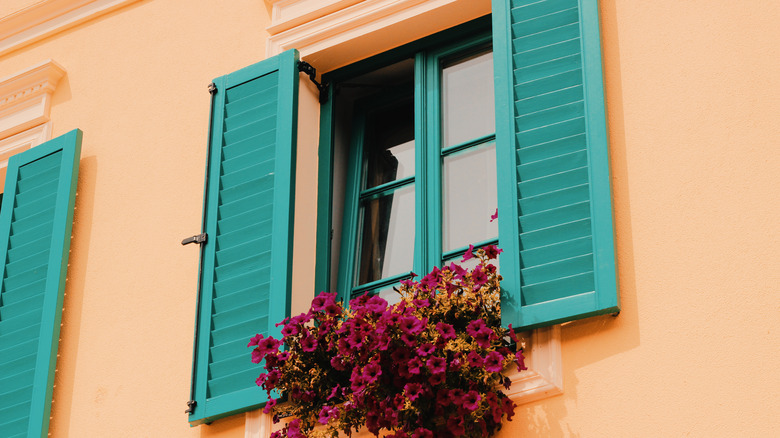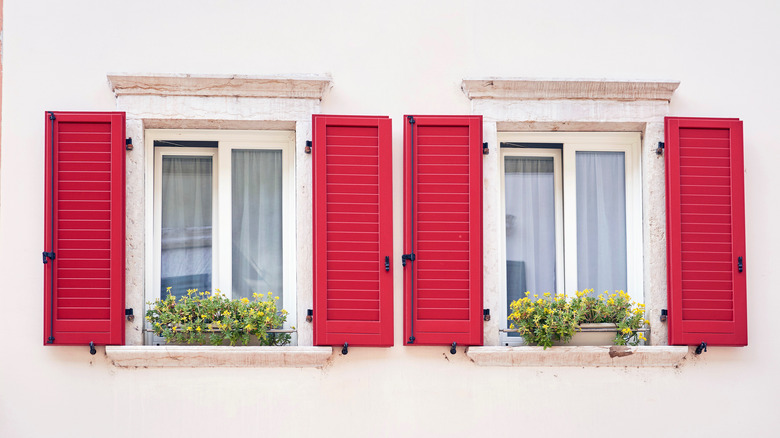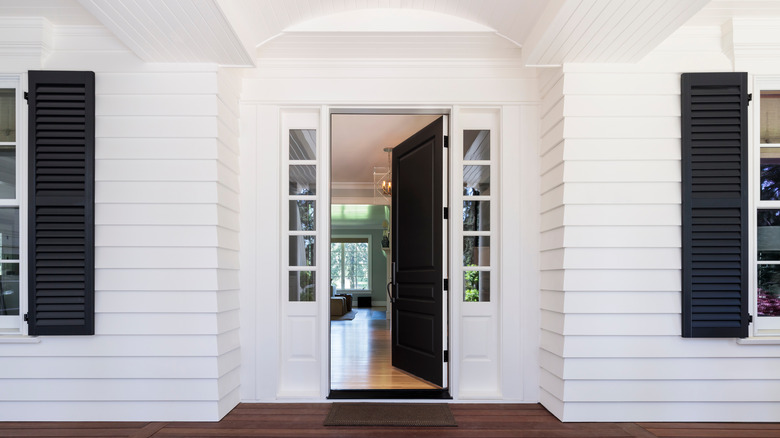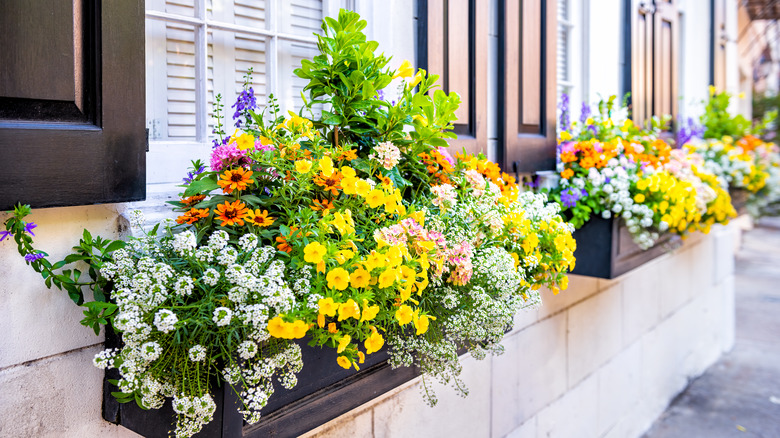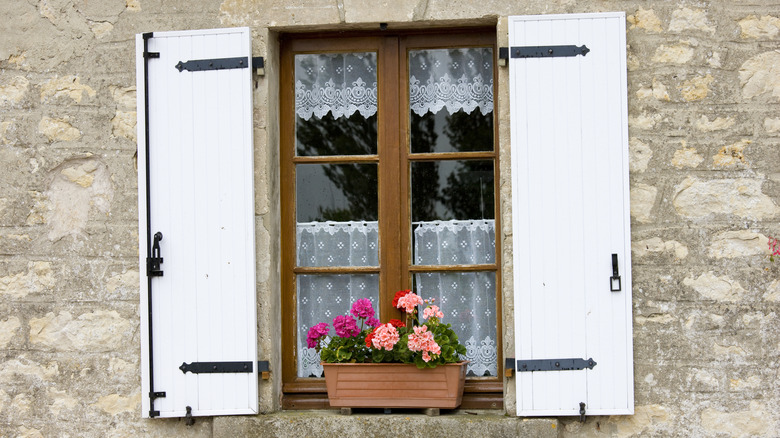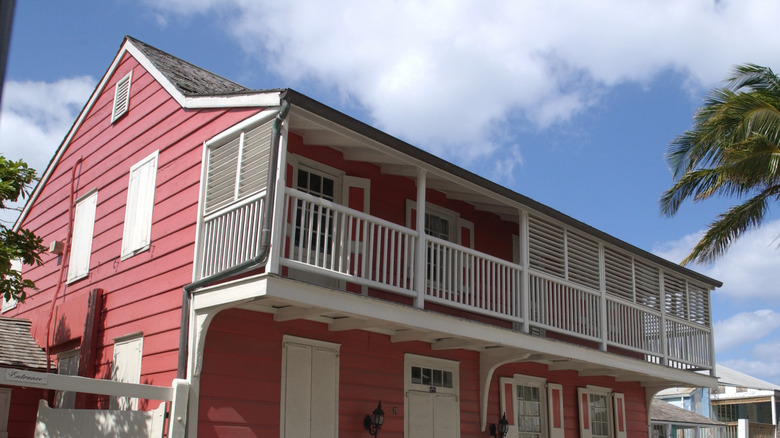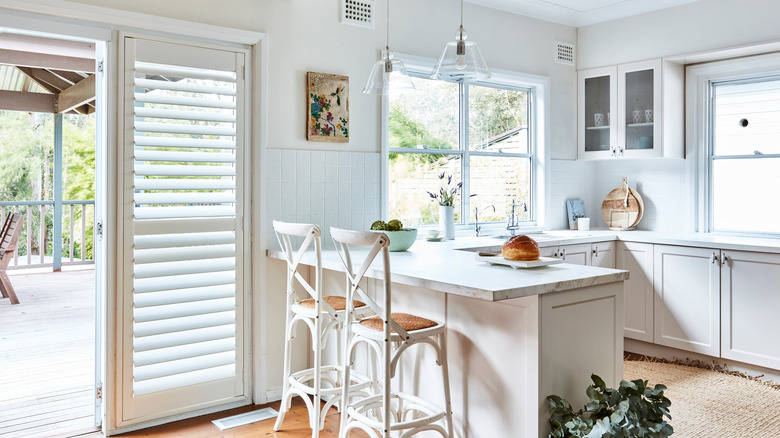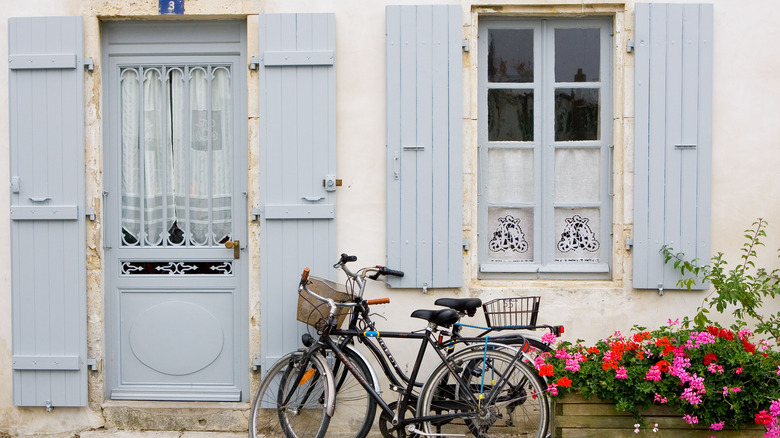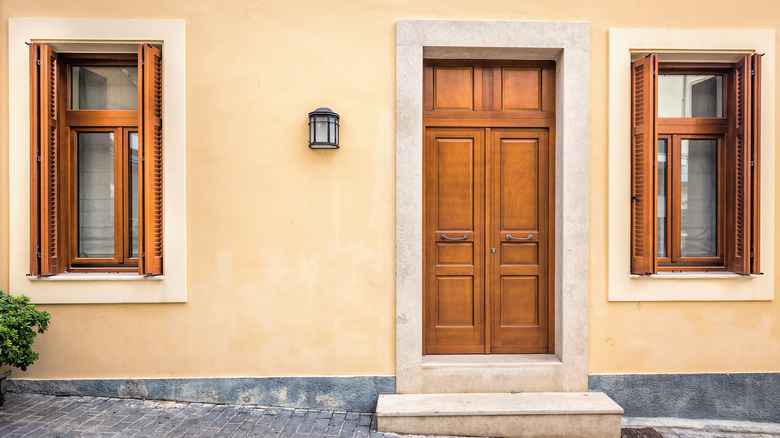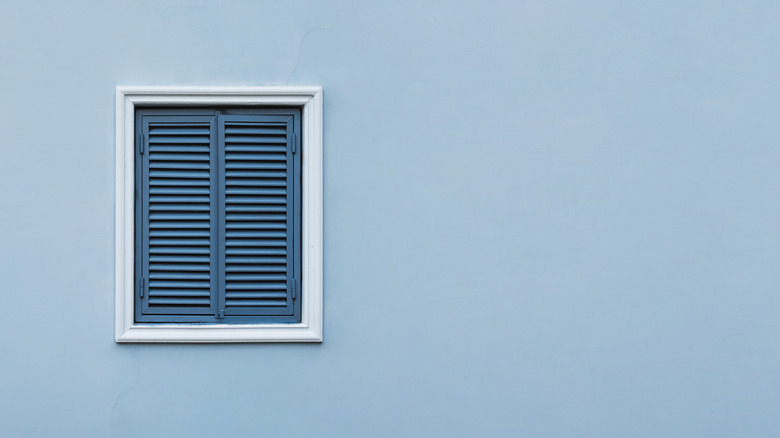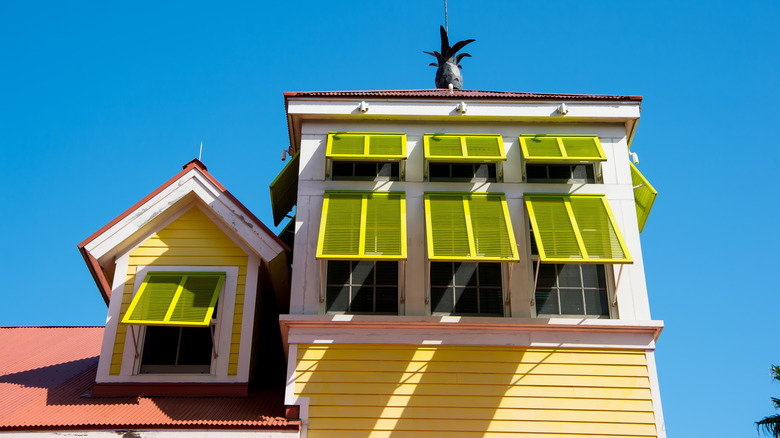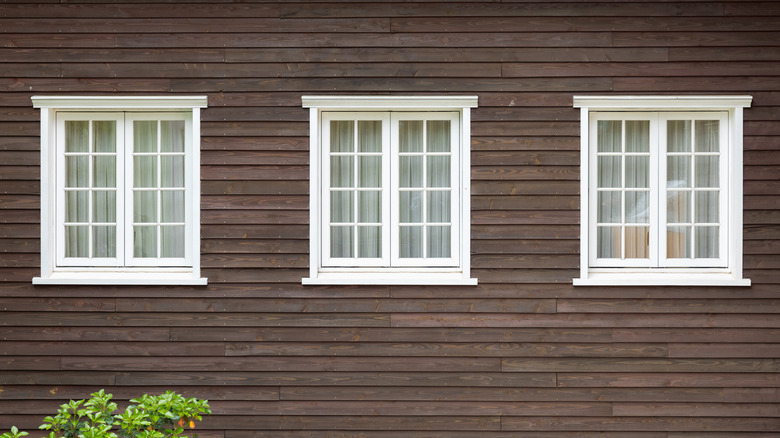Shutter Ideas To Bring The Outside Of Your Home To Life
Suppose your home's exterior is ready for a facelift, or you're looking for a way to make a big first impression with a small investment in time and resources. In that case, you may have considered installing or changing existing shutters. Shutters can be the finishing touch to help the outside of your home look polished and put together. They're relatively inexpensive and quick to set up, making them a simple way to refresh your home's facade.
Long before they were decorative accents, shutters were functional elements that helped protect homes from weather, insulation, intruders, noise, sunlight, insects, and peering eyes. According to ShutterLand, modern inventions like glass, screens, air conditioning, and insulation have negated the need for functional shutters in many of today's homes. In most cases, shutters are purely decorative and permanently attached to exterior walls. Operable shutters are still used for privacy, storm protection in hurricane-prone areas, historical accuracy, or pure aesthetics. For many contemporary styles, like the modern farmhouse trend, shutters have stayed relevant because they help our homes look lived-in and elegant at the same time.
According to ShutterLand, the four basic types of exterior shutters are paneled (seen on colonial revival styles), louvered (used on colonial, cape cod, and Victorian homes), board and batten (popular with farmhouse, French country, cottage, mission, ranch, Spanish, and Mediterranean styles), and Bahama (seen on coastal beach houses and in tropical regions). Shutters made of real wood are required for historic homes, while vinyl and composite materials have been developed with weather resistance and affordability in mind.
There are many ways to get creative with shutters to express your distinctive style. Here are some expert ideas for bringing the outside of your home to life with shutters.
Create a color contrast
Good news for risk-takers and color lovers: Shutters are not required to match your front door or your windows' trim — they can be their own color. Consider a striking shutter-door color combo. Kelly Window & Door recommends lavender shutters with a white door or blue shutters with a red door. To pick two colors that are complementary to one another, use the color wheel.
Contemporary homes are best suited for bright pops of color, says West Magnolia Charm, so if you have a modern home, feel free to experiment with pops of yellow, red, and even pink. Whatever color you choose, you should plan for the shutter colors to complement your home's base color. For example, beyond the classic black shutters on a white base, you can try blue or green shutters on beige homes or teal on an off-white home.
Experiment with matching colors
Your shutters can add visual interest, thoughtfulness, and cohesiveness to your home's facade if painted in the same compelling color as the other accents on your house. This can include your front door, garage door, mailbox, porch furniture, pots, roof, or even seasonal blooms.
Black goes with nearly every architectural style, and it is the most common hue for a door-and-shutter pairing, says Kelly Window & Door. If that is too intense of a shade, navy, white, red, brown, green, and gray are popular choices for a repeating exterior accent color.
To create a layered, coordinated look for your home's exterior, consider a monochromatic color scheme, suggests West Magnolia Charm. Paint your home's siding (aka base), trim, and accent pieces a shade darker or lighter than your shutters. So if you're set on a beautiful blue for your shutters, the rest of your home's exterior can simply fall in line. Want your windows to look big? Matching white shutters to white window trim can make your windows and home appear larger (via HomeAdvisor).
Use plants to liven up your shutters
To give your street view some oomph using greenery, install window boxes under each window, paint them the same color as your shutters, and fill them with complementary plantings. Not only will your home have an upgrade of natural beauty to its exterior aesthetic, but the view from the inside will be improved thanks to your new foliage and the wildlife it attracts, explains Sanctuary Home Decor. Be careful to ensure the window boxes don't block your shutters from opening and closing, per Old House Journal Magazine.
Grow a vine to frame your shutters in colorful climbing foliage and bring natural texture to your home's exterior. Trumpet vine, jasmine, English ivy, and wisteria are popular species, according to Angi, in addition to honeysuckle and bougainvillea. Take care to prune your vine so it doesn't ruin your shutters by scratching or attaching to your wood (via ShutterLand).
Hardware adds a finishing touch
Shutter hardware pieces can be small yet transformational, really bringing extra life and authenticity to your home's facade. If your shutters are purely decorative, your hardware can be too. In other words, you can choose designs just for their aesthetic rather than their function, as per Van Dyke's Restorers. However, if your shutters are operational, you'll need the hinges, straps, and tiebacks to actually work.
Tiebacks, also called "dogs," are the pieces that hold shutters in an open position. They are often shaped in an S-shaped scroll design or can be in designs specific to a region. For instance, they will come in floral and grape designs in New England and sea life in the coastal south (via ShutterLand). Authentic shutter hardware can be made of forged or cast iron. Realistic-looking replicas can be vinyl, and since they're often seen from a distance, they are an affordable substitute for the real thing (via Sanctuary Home Decor).
Wrap a porch with shutters
Consider enclosing an open-air patio, veranda, cabana, balcony, or porch with operable shutters to not only add visual interest and allow airflow, but to gain privacy, weather protection, and more usability of your home's exterior space. Work with a custom shutter maker to install a privacy screen of louvered or Bahama shutters. Porch shutters can be made from natural wood or powder-coated aluminum, according to Palmetto Outdoor Spaces, and are designed to withstand most (but not all) moisture, wind, and the strong rays of the sun. Not only will your outdoor furniture be protected, but you may extend the amount of time per year you can use your outdoor space.
Outdoor shutter privacy screens can even reduce traffic noise, says LAS Shutters + Windows. Whether your open-air room looks out onto a backyard or is situated at the front of your home on a bustling city street, a shutter enclosure will create a transition from outside to in and give your home increased curb appeal when the shutters are both open and closed.
Complement glass doors
Revitalize your home's exterior with interior shutters to augment your glass doors. If you have sliding glass doors or French patio doors that look ho-hum from the outside, operable shutters installed inside can brighten your home's appearance. Louvered or plantation shutters can extend from floor to ceiling and work together with sliding glass doors to protect, shade, and give privacy. When viewed from the outside, the glass doors will appear more dimensional and cleaner than drapery or blinds, and can give your home a glowing look after dark.
Shutters also offer easier upkeep over the long term than fabric options, says California Shutters. They don't interfere with handles on French doors as other window treatments do, and they can be a good solution for very tall, wide, or up-high windows or doors (via Aero Drapery and Blind).
Frame your front door with shutters
Considering that your front door is one of the most prominent fixtures on your home's exterior, a pair of door-size shutters can be a welcoming entry point for your abode, providing an unconventional and dramatic upgrade. According to Decorative Shutters, exterior shutters should appear able to close over the door (even if they will never actually shut). This treatment requires both a slender door and ample space around the door frame. If you have an arched front door, you'll also want to have arched shutters.
Unlike shutters that frame high-up windows on your home's exterior, front door shutters will be seen up close. This is something to keep in mind when selecting materials and hardware. Front doors with narrow sidelight windows on each side can benefit from interior shutters, improving the look of your home's entry from the outside. They are excellent for privacy as well, says Cleveland Shutters.
Install stained wood shutters
Your home is a reflection of your personality, and if "natural," "rustic," or "charming" are any traits that you want to express, consider working with a craftsman to make stained wood shutters that bring the outside of your home to life. While they can require maintenance, natural wood grain shutters can enhance your home's exterior in a very authentic way.
According to All About Shutters, wood was the original shutter material in American architecture. It can last for decades, especially if you choose the right kind of wood. For example, cedar and redwood last longer and are more durable than composite wood shutters (via Timberlane). Using rot-resistant wood is key, says The Craftsman Blog, noting that wood shutters are easier to fix than vinyl, PVC, or composite shutters. Shutters in board and batten style offer the broadest range of possibilities for getting creative with wood types and stains, so if you have a specific look in mind you want to recreate, that might be the best option.
Perk up an empty exterior wall
You can fake a nonexistent window (or two) with a set of closed shutters that match the rest of your home's facade. Perhaps the exterior of your home has a solid wall concealing a garage or a bathroom, and you think a window would balance out the overall appearance of your facade from the street view. According to Vincent Longo Custom Builders, shutters that "conceal" a faux window will appear closed, unlike the other shutters on your home's exterior.
On the other hand, perhaps you have an existing window that you want to patch over, whether you're doing an interior design project that requires a solid wall or you want better insulation. Enclosing a window with inoperable closed shutters is less permanent and can bring more life to the outside of your home. It may also be more cost-effective than filling in a wall with weather-resistant siding or masonry — which can cost $60 per square foot and, in most cases, require the skills of an expert, according to Your Own Architect.
Mix and match
Add personality to your facade by combining shutter styles. If you're in a hot climate, try louvered shutters on the ground level and Bahama shutters on the upper floors for shade, as per Decorative Shutters. Or try paneled shutters on the ground floor and louvered shutters upstairs. This combination is a historic callback to times when privacy was needed on lower levels and airflow was important on upper levels, explains Timberlane. In fact, old-fashioned paneled shutters on the lower floor were often painted white to lighten interiors, while louvered shutters upstairs were painted dark for shade.
Not all windows need shutters, meaning you can install shutters upstairs but not downstairs, for example, says Brick&Batten. The site also recommends bi-fold shutters if your facade is cramped in space. If only installing shutters on some windows, consider wider trim on the others for balance, advises Maria Killam.
Consider removing your shutters
It's possible that the best option for boosting the look of your home's exterior is removing old or ill-fitting shutters. The most common misstep with shutters, even decorative ones, is installing ones that appear to be the wrong fit. If your proportions are off, whether you have narrow shutters alongside triple-wide windows, if they seem unable to close fully over the windows, or if they are really tight on space, consider removing them to help your home look its best, as per From the HartLand.
Generally speaking, if windows are wider than they are tall, skip the shutters, advises Maria Killam, who says removing shutters altogether can update a colonial to a more current farmhouse look. In fact, some styles of architecture are not suited for exterior shutters or traditionally don't have them. These include bungalows, San Francisco Stick Style houses, and Tudor revival houses, as per Old House Journal Magazine. Maybe your home simply has the wrong window styles for shutters, like bay windows, corner windows, or picture windows. In cases like these, it's best to admit the styling doesn't work and remove them.
